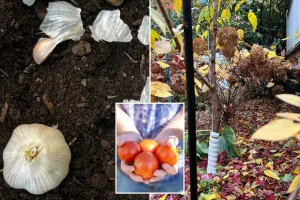Fall Garden Prep: Your Gateway to a Stunning Spring
The crisp autumn air signals not just the end of a garden season, but the beginning of preparation for the next. While many gardeners view fall as the garden’s closing chapter, it’s actually the perfect time to set the stage for a vibrant spring comeback. Those who invest time in autumn garden maintenance will find themselves rewarded with healthier plants, fewer pests, and significantly less work when the warmer months return. By tackling key tasks now—from weed management to soil preparation—you’ll be creating the foundation for next year’s garden success while the weather is still pleasantly cool for outdoor work.
Weed control tops the list of fall priorities, and for good reason. Pulling weeds by their roots now dramatically reduces their springtime population, saving you countless hours of future labor. Consider investing in a long-handled tool like Grampa’s Weeder, which transforms this potentially back-breaking chore into something almost enjoyable. The tool allows you to extract entire root systems while standing, preserving your knees and back. While you’re clearing beds, take time to thoroughly rake areas where fungal diseases like black spot or mildew appeared during the growing season. This simple act prevents pathogens from overwintering in the soil, protecting next year’s plants from infection before they even begin growing. Remember to dispose of these disease-carrying leaves and debris in the trash rather than the compost pile to prevent spreading problems to next season’s garden.
Disease prevention extends beyond raking. Take a critical look at your fruit trees and remove any shriveled, “mummified” fruit still clinging to branches, as these can harbor pests and diseases through winter. Garden supplies deserve attention too—those tomato cages and plant stakes that supported your summer bounty need cleaning before storage. Create a solution of one part bleach to nine parts water, or simply use household disinfectant spray, allowing items to air dry completely before storing them away. This disinfection process breaks disease cycles that could otherwise continue next season. While you’re maintaining equipment, don’t forget to clean, sharpen, and oil your hand tools. Few spring frustrations match heading out to plant your new seedlings only to discover your spade has rusted over during winter storage. A light coating of oil on metal surfaces after cleaning will keep tools ready for action when warmer weather returns.
Protecting your landscape investments is another crucial fall task. If you planted fruit trees this year, install protective guards around their trunks to prevent damage from mice and rabbits that may gnaw on bark during food-scarce winter months. Coiled plastic trunk wraps offer excellent protection, though wire mesh guards or more decorative metal tree surrounds work equally well. Safety considerations should extend to established trees as well—carefully examine branches for any that are split, dead, or broken, and remove them before winter storms arrive. Damaged limbs can tear off during high winds or under heavy snow loads, potentially causing injury to people or damage to property. Taking care of these hazards now prevents emergency tree work during challenging winter conditions and protects your home and loved ones through the stormy season.
Fall presents the perfect opportunity to prepare for next year’s garden expansion. If you’re planning new beds for spring, you can save considerable effort by starting the process now. Rather than struggling with sod cutters or hours of digging when spring fever hits, employ the simple technique of sheet mulching. Define your future bed area, then cover it completely with large pieces of cardboard or several thick layers of newspaper. Secure these materials with landscape staples or heavy stones, then top with a few inches of compost or mulch. Over winter, this covering will smother existing grass and weeds while simultaneously beginning to decompose, creating a ready-to-plant bed by spring. If some cardboard remains intact when planting time arrives, simply leave it in place and dig planting holes right through it—the remaining material will continue breaking down while suppressing weeds around your new plants.
Existing vegetable beds deserve attention too—clear out spent plants and lightly turn the soil while incorporating organic amendments that will enrich it over winter. Adding compost and well-rotted manure now allows these materials months to break down and integrate with your native soil, creating an optimal growing environment for next season’s vegetables. If soil tests have indicated acidic conditions, now is also the ideal time to incorporate lime, giving it ample time to modify soil pH before spring planting. Perhaps the most joyful fall garden task is planting spring-flowering bulbs and garlic. This act of faith—burying seemingly lifeless bulbs in cooling soil—creates a spectacular gift for your future self. While earlier planting generally produces stronger results, you can continue planting bulbs until the ground becomes too hard to dig. Each bulb planted now represents a burst of color or flavor that will emerge months later, providing a welcome celebration of winter’s end with minimal spring effort. This forward-thinking garden work transforms fall from a season of endings into one of thoughtful beginnings.















